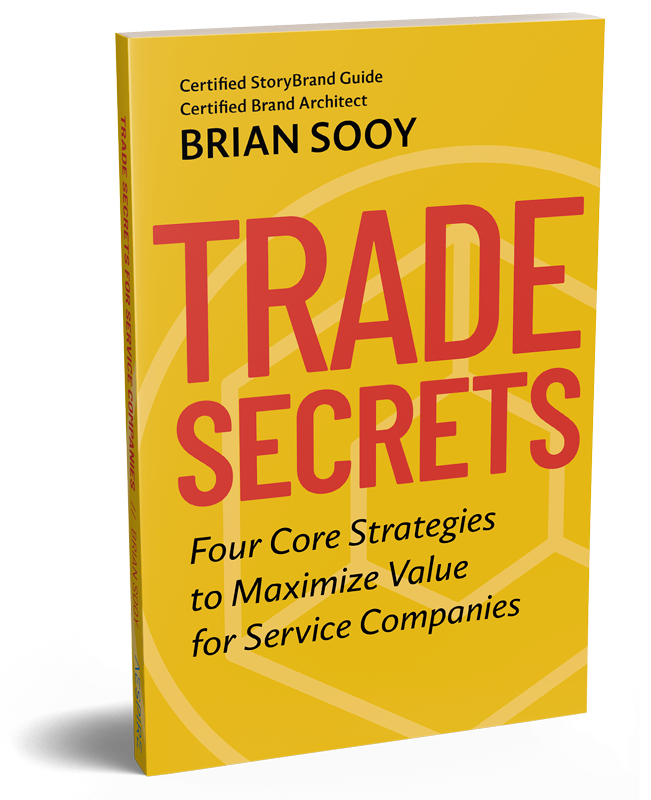What you’ll find inside Trade Secrets
Brand Alignment in Trade Secrets
Before you dive in, here’s a quick summary of what you will find in Trade Secrets.
The CORE framework revolves around four fundamental strategies for integrating, optimizing, and aligning your brand strategy with business operations. These core strategies are:
- Clarity defines your company’s character, shared values, and culture. Clarity ensures that all brand messages and communications are consistent and easily understandable, align your team, and resonate effectively with your target audience.
- Orientation aligns your company with the needs and preferences of your preferred audience. Orientation aligns the category and problem you solve with the customer’s wants and needs, positioning your brand to become relevant and meaningful to them.
- Relevance builds authority and credibility with customers, employees, partners, and the community. Relevance leads to stronger relationships that are cultivated through trust, engagement, and community.
- Experience is about showing up, designing, and delivering memorable and positive experiences to your team and customers. Every customer interaction should demonstrate your brand’s value, improve its perception, and win trust.
By integrating these strategies with your business strategy, your company can consistently communicate its value, align itself meaningfully with your audience, build lasting relationships, and deliver exceptional experiences that distinguish your brand in the marketplace.
Table of Contents
Buy NowPART ONE: THE CORE FRAMEWORK
1. Branding is Not the Villain
2. Orient Your Business Toward Your Customers
3. Aligned Companies Win in the Marketplace
4. What Is a Brand?
5. The CORE Framework
6. Clarity
7. Orientation
8. Relevance
9. Experience
10. Unleash the Extraordinary
PART TWO: THE CORE TOOLKIT
11. Simple Brand Strategy
12. The Clarity Process
13. The PASS Model
14. Worksheets
PART THREE: CASE STUDIES
15. Integrate with Business Made Simple
16. Case Study: Home Services
17. Case Study: Group Benefits Insurance
18. Case Study: Financial Advisor
19. Sales Funnels POV
The CORE Brand Value Framework
Buy NowChapter 1: Integrate Your Brand
- People have strange ideas about brands. Branding is not the villain. A logo is not a brand.
- Some business coaches argue that marketing must come before branding to create revenue that fuels the business. That’s an odd argument because your company name, visual identity, design choices, messaging, tone of voice, and market presence — how you show up in the marketplace and serve customers — are all brand strategy elements. Branding must be embedded and integrated into your business from the start.
Chapter 2: Orient Your Business
- Internal silos and the marketplace create turbulence and crosswinds that compound the issues and threaten to push your service business off course. Silos prevent your company from following a successful path from where you are to where you want to be.
- One essential strategy — brand alignment — can unify and stabilize your small business for long-term value and growth.
Chapter 3: Aligned Companies Win
- Many service business owners don’t understand how brand strategy (a long-term plan to outmaneuver competitors, empower customers, and design a sustainable competitive advantage) must integrate with their business strategy (leadership, operations, sales, performance, HR, marketing, etc.) to realize increasing profits over time.
Chapter 4: Brand Alignment Manages Tension
- Without brand alignment to help you manage the positive tension between your company, category, and customers, your business playbook isn’t complete.
Chapter 5: The CORE Framework
- Understanding the CORE principles is practical because you can apply Clarity, Orientation, Relevance, and Experience to design the interactions between your company, customers, products, and services.
Chapter 6: Clarity
- Clarity is the clear and focused path for communication, the bridge between the company and its customers. Clarity principles and practices define your brand at its core so your team is confident and customers know who you are.
Chapter 7: Orientation
- When you position your brand as the only choice to meet the needs of the category and unique buying tribe, it builds deeper relationships. The category defines the brand as the right fit for the community’s identity, goals, beliefs, and behaviors.
Chapter 8: Relevance
- What matters most for your brand is not how it looks to you but how customers perceive it. You can influence that perception, but ultimately, customers determine if your brand is different enough to deserve their attention. If your brand is no longer seen as desirable to customers, it risks fading into irrelevance.
Chapter 9: Experience
- Words, images, and experiences are the leading edges of your communications. They are the elements most often associated with your brand. Your company speaks with your audience through every verbal, visual, and experiential touchpoint, whether you intend to or not. Your company’s personnel are its most important touchpoint.
Chapter 10: Unleash the Extraordinary
- The secret to attracting people to your niche isn’t to out-market your competition. The secret is in understanding what other people find extraordinary in what you find ordinary.
The CORE Toolkit
Buy NowChapters 11–14: The CORE Toolkit
- A comprehensive overview of the brand alignment and marketing touchpoints that integrate sales and marketing for revenue growth.
Chapter 15: Integrate with Business Made Simple
- If your small business is like an airplane, you may be trying to navigate — and fly — without one key component. There’s no clear way to unify sales and marketing without brand alignment.
Chapters 16–19: Case Studies
- Explore how a home services company, a group benefits insurance agency, and a wealth management firm integrated their brand, messaging, and marketing with every aspect of their companies for transformational results.





